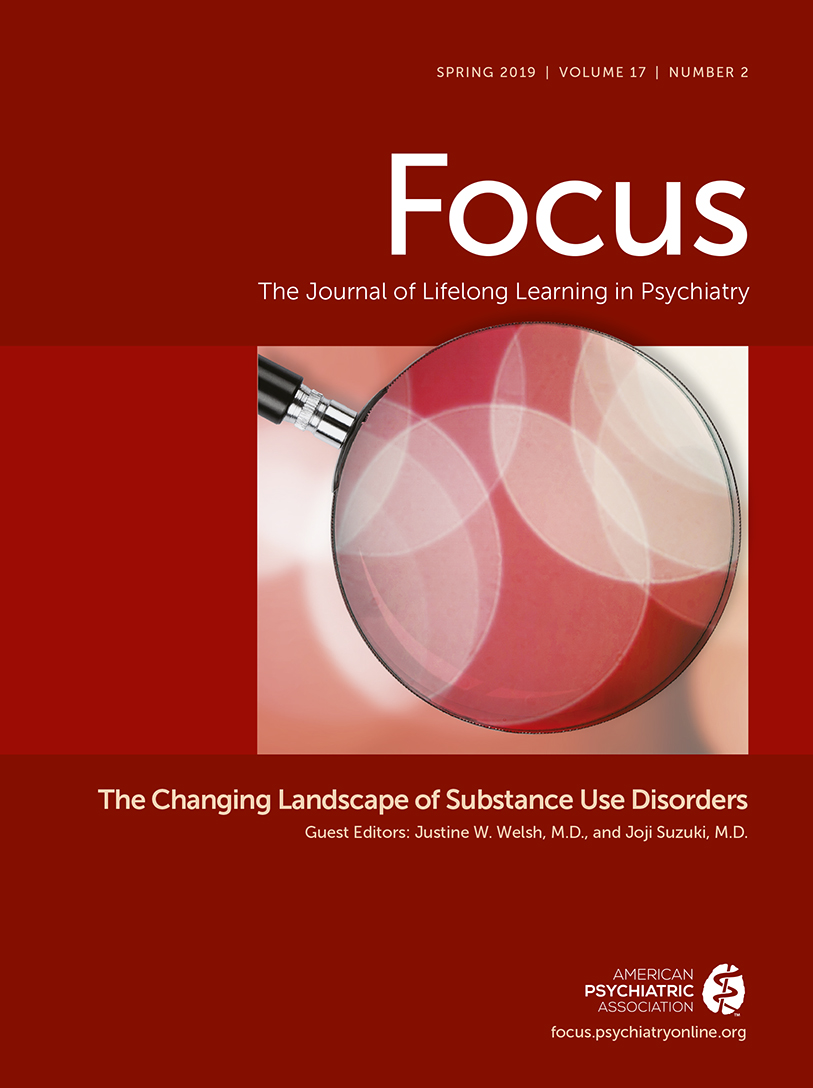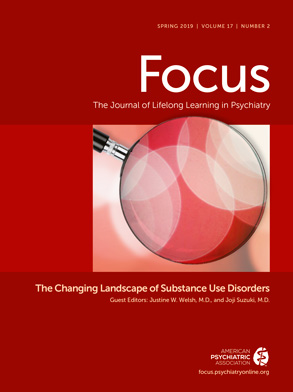Substance use is commonly first experienced in adolescence (
1), a time of rapid brain development (
2). Yet, brain development throughout adolescence is functionally imbalanced. The limbic system that drives sensation seeking, reward, and impulsivity is already developed in early adolescence, whereas the prefrontal cortex (PFC) that provides the individual with impulse control, judgment, and decision making requires development well into young adulthood (
3). Functional MRI (fMRI) studies that include measures obtained during go/no-go paradigms (a measure of inhibitory control) report sensation seeking to be high among adolescents versus low to medium among adults and adolescent impulsivity to be medium to high versus low to medium in adults (
4); fMRI observations of a blunting of PFC inhibition circuitry in adolescents is now considered a measure of risk for the development of subsequent substance use disorders (
5).
Alcohol, cannabis, and tobacco are the most common substances used by adolescents in the United States. In 2017, 7.4 million (1 in 5) individuals ages 12 to 20 drank alcohol in the past month, with 1 in 8 being binge drinkers within the past month; findings for 2015 and 2016 were similar (
6). Decreases have occurred for several substances across eighth, 10th, and 12th graders, including synthetic cannabinoids, so-called bath salts (cathinones), and the prescription opioids OxyContin and Vicodin (
1). Whereas cigarette smoking by adolescents has continued to decline, recent data suggest that the often flavored nicotine products, including E-cigarettes, may contribute to increases in new initiations to cigarette use (
7). Although adolescent use of inhalants (vapors from toxic substances such as butane) is less than that of cigarettes, inhalant-induced neurobiological damage is so severe that the 2017 increase of 4.7% in inhalant use by eighth graders (
1) is of significant concern.
Regarding cannabis, in 2017, adolescents in the combined eighth, 10th, and 12th grades increased cannabis use by 1.3%, to a total of 23.9% across the three grades (annual marijuana prevalence is 10%, 26%, and 37% in grades 8, 10, and 12, respectively) (
1). Furthermore, almost one in every 16 high school seniors (5.8%) uses marijuana daily (
1), and there is an early report of increases in daily use among adolescents in one of the first two states that have legalized cannabis (
8). Cannabis is perceived across the United States as a safe recreational drug, yet frequent and heavy cannabis use in young adulthood has been shown to increase the risk for subsequent development of psychosis (
9) as well as anxiety disorder (adjusted odds ratio [OR]=3.2, 95% confidence interval [CI]=1.1–9.2), but not depression, and cannabis use disorder (adjusted OR=2.2, 95% CI=1.1–4.4) (
10).
In addition, a 2017 published study (
11) assessed 65 adolescent females and males for brain resting-state functional connectivity between the caudal anterior cingulate cortex and superior frontal gyrus across time. Whereas increases in resting-state functional connectivity were present in the healthy control group, decreases were found in the individuals with cannabis use disorder and tested negative for cannabis. In addition, the smallest levels of connectivity were found in the cannabis users with the highest levels of prestudy cannabis use; the cannabis users also manifested measures of a lower intelligence quotient and slower cognitive function.
The most effective psychosocial treatment for cannabis use disorder appears to be combined cognitive-behavioral therapy and motivational enhancement therapy (
12). A meta-analysis of 23 international randomized controlled trials involving 4,045 participants demonstrated optimal outcomes if the interventions included more than four sessions delivered for longer than one month, plus abstinence-based incentives. The patients receiving these sessions reported significantly fewer days of cannabis use in the previous 30 days (95% CI=3.08–8.26; N=1,144 participants). Treatment outcomes of cannabis or other substance use disorders are significantly worsened when patients manifest comorbid depressive disorder or posttraumatic stress disorder (
13).
The National Institute on Drug Abuse has outlined 13 principles (
14), based on clinical research, which are summarized below into four guidelines for effective assessment and treatment of adolescents.
1.
Substance use or substance use disorder is identified as soon as possible; once identified, other mental health conditions, violence, child abuse, or risk of suicide are to be identified and addressed. Testing for sexually transmitted diseases, including HIV, hepatitis B, and hepatitis C, is important.
2.
The treatment process is tailored to address the unique needs of the adolescent and the needs of the whole person; assessment and treatment also include the family and community.
3.
Drug use monitoring occurs at the beginning of treatment, throughout treatment, and as part of follow-up assessment. Treatment includes psychosocial/behavioral treatment and has the potential of being combined with pharmacotherapy to treat substance use and/or comorbid mental disorders.
4.
Adolescents benefit from a drug use intervention, regardless of whether a substance use disorder exists, annual medical or otherwise scheduled visits present an ideal opportunity to ask adolescents about substance use, and legal interventions and sanctions and/or family pressure helps adolescents to enter and remain in treatment.
When possible, the treatment team ideally comprises the clinician(s), parents, potentially other family members or significant others, and the adolescent all working together. A critical finding of clinical research is that adolescents who use substances by age 13, especially males, are at significant risk to develop a substance use disorder later (
15). A most important challenge for parents is maintaining awareness of their adolescents’ companions and where their children are when not at home or school; this is a robust predictor of risky adolescent behavior, including using drugs and alcohol (
16). Protective and risk factors have been identified from the perspective of the family, the individual, and the community and schools. Family-based protective factors include the provision of structure, limits, rules, monitoring, and predictability; the presence of supportive relationships with family members; and communication of clear expectations for behavior and values (
17).

